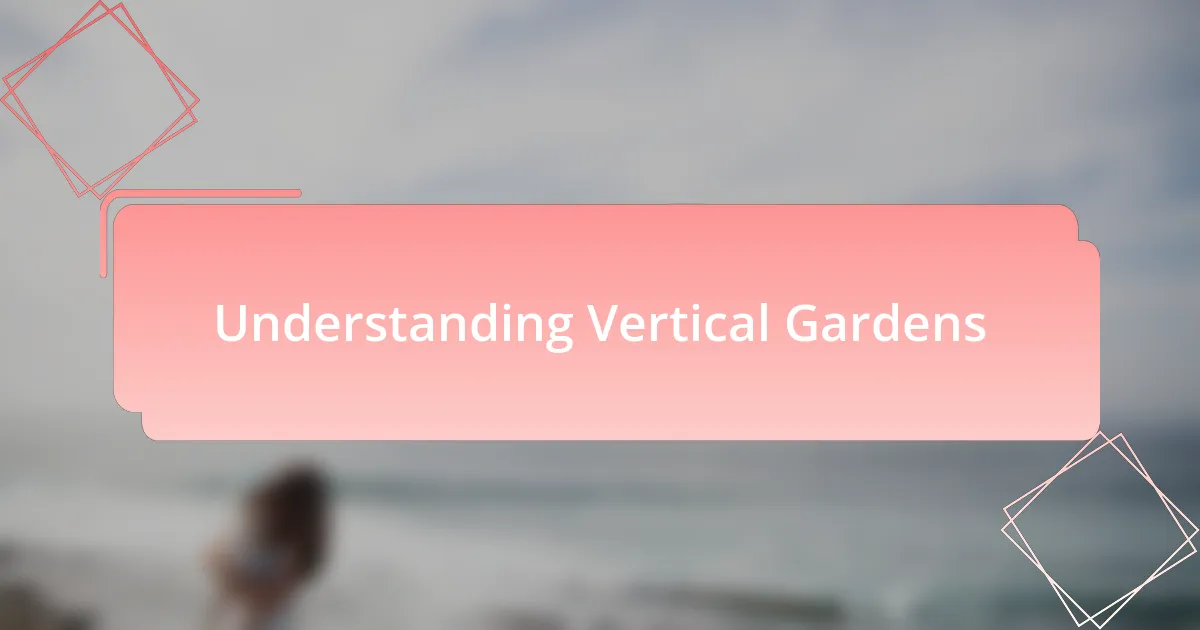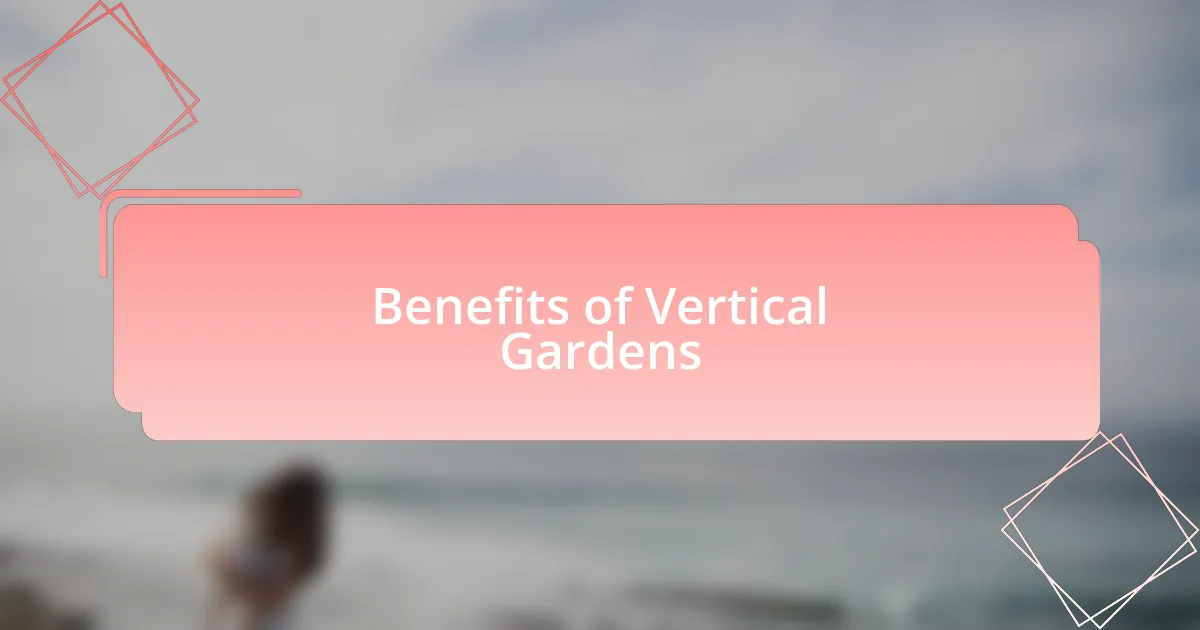Key takeaways:
- Vertical gardens, or living walls, maximize space and enhance aesthetics while improving air quality and offering mental health benefits.
- Choosing the right location, considering sunlight, water access, wind exposure, and temperature is crucial for plant success.
- Materials such as sturdy planters, solid frames, and quality soil are essential for optimizing vertical gardening success.
- Regular maintenance, including watering, pruning, and monitoring plant health, is key to sustaining a flourishing vertical garden.

Understanding Vertical Gardens
Vertical gardens, often referred to as living walls, are a creative way to bring greenery into spaces where traditional gardens might not thrive, such as small balconies or urban backyards. I remember the feeling of excitement when I first discovered the concept; it felt like a green revolution right at my fingertips. How wonderful it was to think that I could create an oasis, transforming blank walls into lush, vibrant habitats!
These gardens utilize a variety of plants, often selected for their ability to thrive in vertical conditions. When I chose a mix of herbs and ornamental plants for my own garden, each selection felt personal, like choosing friends for a dinner party. Have you ever felt that joy of nurturing something from the ground up? It’s an experience that connects us deeply to nature and reminds us of the simple pleasures in life.
The beauty of vertical gardens lies not only in their aesthetics but also in their practicality; they improve air quality and provide insulation, making them a smart choice for environmentally conscious gardeners. I often reflect on how these gardens can serve as a conversation starter, drawing others in with their charm and unique design, inviting a sense of community among neighbors. Isn’t it fascinating how something as simple as planting can bring people together?

Benefits of Vertical Gardens
Creating a vertical garden offers incredible space-saving benefits, especially for those of us living in urban environments. I recall the moment I realized I could utilize an otherwise unusable wall in my apartment. The excitement of reclaiming that space for greenery was liberating; it felt like I was expanding my living area without needing to move!
Another wonderful perk is the diversity of plants you can grow in a vertical garden. I’ve experimented with everything from aromatic herbs to vibrant flowers, and each choice has its own rewarding experience. Isn’t it exhilarating to step outside and instantly be surrounded by a mini-ecosystem that you meticulously curated? The colors, scents, and textures come together to create a lively atmosphere that brightens my day.
Beyond aesthetics and practicality, these gardens also promote mental well-being. I remember the soothing moments spent tending to my plants after a long day; it was a form of mindfulness that allowed me to connect with nature and decompress. Wouldn’t you agree that having that green touchpoint right at your fingertips can transform not just a space, but your overall mood as well?

Choosing the Right Location
When it comes to choosing the right location for your vertical garden, sunlight is a crucial factor. I remember the time I underestimated how much direct sun my chosen spot received. After a week, my herbs struggled to thrive, and I soon shifted them to a sunnier wall where they flourished. Have you noticed how vital sunlight is for plant health? It’s one of those essentials we can’t overlook.
Next, consider the proximity to water. I found that placing my vertical garden near a water source made maintenance a breeze. Initially, I had my plants on a distant wall, but I quickly learned that hauling a watering can across my space was less than convenient. Positioning your garden nearby allows you to create a routine and keep your plants hydrated without extra effort.
Lastly, be mindful of wind exposure and temperature variations. I once had a beautiful vertical garden that looked fantastic but was too exposed to the harsh afternoon winds. I felt disheartened watching my fragile plants struggle. Since then, I make it a point to survey the area for shelter from strong gusts. Have you considered how weather patterns in your area might affect your vertical garden’s success? Finding that balance can make all the difference.

Materials Needed for Vertical Gardening
When diving into vertical gardening, choosing the right materials is crucial for your success. I remember breaking down my project into components and realizing I needed sturdy planters. Initially, I thought ordinary pots would do, but I quickly discovered that lightweight, durable materials like felt or plastic greatly improved drainage and made it easier to manage the weight on my wall. Do you have a preference for style that can also serve a functional purpose?
Next on the list is a solid frame or structure to support your plants. I once tried using a simple wooden trellis, but it didn’t hold up to the additional weight of multiple plant pots. After a bit of trial and error, I invested in a heavy-duty metal grid that offered both stability and an open design that allowed for airflow. Have you considered what kind of support system will not only elevate your plants but also complement your space?
Lastly, don’t underestimate the importance of quality soil and planting mix. During my initial attempts, I relied on regular potting soil and found that my plants weren’t thriving. Switching to a specialized mix for vertical gardening made a noticeable difference in nutrient retention and aeration. What types of soil do you think your plants will thrive in? Choosing the right materials ultimately sets the foundation for your vertical garden’s health.

Personal Tips for Success
When embarking on your vertical garden journey, I found that planning is just as vital as the materials themselves. I vividly remember sketching out my garden’s layout, which not only helped visualize the space but also revealed areas that needed more sunlight or water access. Have you mapped out how your plants will interact with one another?
Another tip that truly transformed my garden’s success was the power of plant selection. Initially, I filled my vertical space without much thought, leading to overcrowding and competition for resources. After observing which plants thrived together, I started grouping varieties with similar water and light needs, and that made all the difference. What combinations are you considering for your own garden?
Lastly, don’t overlook the importance of commitment in nurturing your vertical garden. I learned this the hard way when I neglected my plants for a week and returned to find them wilting. Regular watering and a schedule for checking on their growth not only keeps them healthy but deepens your bond with each plant. How often do you plan to tend to your green creations?

Maintaining Your Vertical Garden
Keeping your vertical garden flourishing requires consistent attention and care. I remember the first time I noticed the leaves of my favorite herbs turning yellow; it was a stark reminder that they relied on me. Regular checks for signs of distress not only helped me avoid bigger issues but also allowed me to celebrate their growth. How do you plan to keep an eye on your plants?
Watering can be a delicate balance. I once overwatered my succulent collection, and watching them droop was painful. Since then, I’ve created a simple moisture-checking routine, using my finger to gauge the soil’s dryness before adding more water. Have you found the right watering technique that works for your vertical garden?
Pruning is another essential part of maintaining a vertical garden. The first time I trimmed back an overzealous vine, I felt nervous, fearing I had harmed it. However, that careful snip encouraged new growth and freshness. Engaging with the plants in this way has taught me to embrace the process of shaping and nourishing them. How do you feel about getting your hands a bit dirty during maintenance?